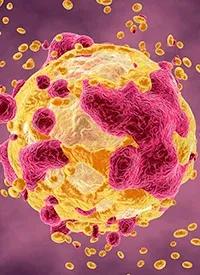Pembrolizumab With COPDAC-28 Consolidation Increases PET Negativity in Classical Hodgkin Lymphoma
The addition of pembrolizumab to COPDAC-28 consolidation may augment responses to treatment in pediatric and young adult patients with high-risk classical Hodgkin lymphoma who experience a slow early response to frontline chemotherapy.

The addition of pembrolizumab (Keytruda) to COPDAC-28 (cyclophosphamide, vincristine, prednisone/prednisolone, and dacarbazine) consolidation may augment responses to treatment in pediatric and young adult patients with high-risk classical Hodgkin lymphoma (cHL) who experience a slow early response (SER) to frontline chemotherapy, according to findings from an updated interim analysis of the phase 2 KEYNOTE-667 trial (NCT03407144) presented at the 2023 ASCO Annual Meeting.1
Following 7 months of additional follow-up of 16.8 months (range, 2.3-36.4), 85% of patients with high-risk cHL and a SER (n = 62) had a late response assessment. In this group, 66% and 34% of patients were PET negative and PET positive by blinded independent central review (BICR), respectively. Similarly, 85% of patients with high-risk cHL and a SER underwent a late response assessment by investigator. The PET-negative and PET-positive rates were 70% and 30%, respectively.
The open-label KEYNOTE-667 study included patients with newly diagnosed, treatment-naïve cHL who were 3 to 25 years old, had measurable disease, a Karnofsky performance score of at least 50 for those who were at least 16 years of age, and a Lansky Play-Performance Scale score of at least 50 for those under 16 years of age. Patients were divided into 2 groups based on disease stage: group 1 or low risk (stage IA, IB, or IIA without bulky disease) and group 2 or high risk (stage IIEB, IIIEA, IIIEB, IVA, or IVB). Stratification occurred based on age (3 to 17 years of age vs at least 18 years of age) and risk group (low vs high).
Group 2, which was the focus of the analysis presented at ASCO, received OEPA (vincristine, etoposide, prednisone/prednisolone, and doxorubicin) induction for 2 cycles before proceeding to early response assessment by PET and CT/MRI. Those who were found have a rapid early response received non-study treatment at the investigator’s discretion, and patients who had a SER received COPDAC-28 for 4 cycles in combination with pembrolizumab at a doses ranging from 2 mg/kg up to 200 mg intravenously every 3 weeks for patients between the ages of 3 and 17 years, or 200 mg intravenously every 3 weeks for those 18 years of age and older. Late response assessment was then conducted, and those who were PET positive underwent radiotherapy. All patients subsequently received pembrolizumab monotherapy every 3 weeks for up to 17 cycles.
The primary end point of the study was objective response rate. Secondary end points included rate of PET negativity by risk group following treatment, event-free survival, exposure to radiotherapy, safety, and overall survival, among others.2
In the high-risk, SER population, the median age was 14.0 years (range, 5-22), nearly all patients were 3 to 17 years of age (94%), and patients had the Ann Arbor disease stages of IV (66%), III (27%), and II (6%). Patients were female (52%), white (77%), and had bulky disease (47%); cHL subtypes consisted of nodular sclerosis (79%), mixed cellularity (15%), and lymphocyte rich (2%).1
Among patients who underwent a late response assessment by BICR and were found to be PET negative (n = 35), the median age was 14.0 years (range, 5-22). Ann Arbor disease stages included IV (71%), III (26%), and II (3%). The cHL subtypes were nodular sclerosis (77%), mixed cellularity (20%), and lymphocyte rich (3%). Patients were female (57%), white (83%), and had bulky disease (46%).
Comparatively, among those who were PET positive by BICR (n = 18), the median age was 15.5 years (range, 7-19). Most patients were female (50%), white (72%), and had bulky disease (56%). Patients had Ann Arbor stage IV (50%), III (39%), and II (11%) disease, and cHL subtypes included nodular sclerosis (78%) and mixed cellularity (6%).
At the March 1, 2023, data cutoff, 55% of patients had completed treatment, and 37% were undergoing ongoing treatment with consolidation/maintenance. Overall, the median time on pembrolizumab was 11.0 months (range, 1 day to 11.8 months).
In terms of safety, any-grade adverse effects (AEs) were reported in 87% of patients with the most common including headache (18%), nausea (18%), cough (16%), and COVID-19 (16%). The rates of grade 3 or 4 and serious AEs were 34% and 21%, respectively.
Notably, no AEs or treatment-related AEs (TRAEs) led to death, but both resulted in discontinuation of treatment in 2% and 2% of patients, respectively. TRAEs occurred in 61% of patients, including those of grade 3 or 4 TRAEs (16%) and serious TRAEs (6%). AEs led to treatment discontinuation in 1 patient (2%).
References
- Vinti L, Daw S, Alvarez CS, et al. Efficacy and safety of pembrolizumab (pembro) in children and young adults with newly diagnosed classical Hodgkin lymphoma (cHL) with slow early response (SER) to front-line chemotherapy (chemo) in the phase 2, open-label, KEYNOTE-667 study. J Clin Oncol. 2023;41(suppl 16):10027. doi:10.1200/JCO.2023.41.16_suppl.10027
- Safety and efficacy of pembrolizumab (MK-3475) in children and young adults with classical Hodgkin lymphoma (MK-3475-667/KEYNOTE-667). ClinicalTrials.gov. Updated August 14, 2023. Accessed August 17, 2023. https://classic.clinicaltrials.gov/ct2/show/NCT03407144



